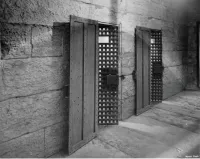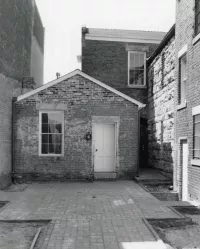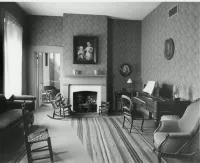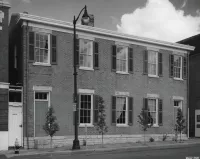Share what you know,
and discover more.
Share what you know,
and discover more.
Jun 15, 1970
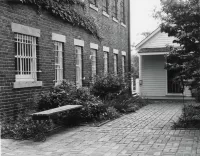
-

- Charmaine Bantugan
National Register of Historic Places - Jackson County Jail and Marshal's House (Jackson County Jail and Marshal's House and Museum /Jackson C)
Statement of Significance: The restored Jackson County Jail of 1859 and Marshal's House of 1859-1860 has been converted to adaptive use as a museum and head- quarters for the Jackson County Historical Society. This complex of buildings is significant as an example of an unusual building type to be selected for restoration. As such, these buildings broaden the range of kinds of architectural examples surviving from the mid-nineteenth century in west central Missouri. In addition, the jail and marshal's house were designed with a high degree of craftsmanship employed in the construction to make a maximum-security stronghold. The survival of the original specifications enhances the buildings' importance as architectural examples. These specifications were used as a guide in the restoration. The jail had a role in local history, notably during the Civil War and its aftermath. The Jackson County Court ordered the jail built in 1859. The structure replaced an 1841 brick building which was of inadequate size to serve the rapidly growing county. An earlier log jail, constructed in 1827, burned and had been replaced with the 1841 structure. (Jackson County Historical Society, brochure on the restored jail and marshal's house, n.d.) The present building was used as a military prison and provost marshal's headquarters by the Federal troops during the Civil War. Two Civil War battles occurred in the vicinity of the jail, the Battle of Independence (1862) and the crucial Battle of Westport (October 21-23, 1864). (W. Howard Adams, "How to Turn a Jail into a Historical Museum," Museum News, December, 1961, Vol. 40, No. 4, p. 29.) Among well-known prisoners held at the jail was William Quantrill, the Southern guerrilla leader. Quantrill was released from the jail by authorities in the winter of 1860. (Milton F. Perry, Museum Curator, Harry S. Truman Library, information in a letter to the Missouri State Historical Survey and Planning Office, March 12, 1970.) He had been imprisoned there following a border raid in a prelude to the Civil War. ("Jackson County Jail," Historic Preservation, 1959, Vol. 11, No. 3, p. 112.) Two other prisoners who receive considerable publicity during their imprisonment were Frank James, brother of Jesse James and Rev. Abner Holton Deane (Perry, March 12, 1970.) Frank James awaited his trial at the jail after his surrender in 1882. (Adams, 1961, p. 29.) The marshal's account book for the period of James' imprisonment is in the collection of the Jackson County Historical Society. This book lists the cost to the county for keeping him. (Perry, March 12, 1970.) The controversy over the imprisonment of Rev. Deane prompted the Missouri artist, George Caleb Bingham to paint a portrait of Deane in jail reading the Bible. This painting is now owned by William Jewell College, Liberty, Missouri. (Perry, March 12, 1970.) Deane, a Baptist minister who felt " ... his commission to preach the Gospel came, not from the state but from God..." refused to take the oath of allegiance which was required of ministers. (J.C. Maple and R.P. Rider, Missouri Baptist Biography, III, 1918, pp. 101-103; and The Missouri Historical Review, XXXV, January 1941, p. 306. The building was expanded in 1900-1901. (Logan O. McKibbin, Architectural Consultant Field Report, June, 1969.) In 1933 its function as a jail was discontinued. From 1941 to 1958 the local American Legion post used the building. Their announcement of intention to raze the then derelict structure prompted the preservation effort of 1959. The effort to preserve the Jackson County Jail and Marshal's House provides an exemplary case history of the effects of such a project within a community. A growing awareness of history in Jackson County was awakened by the decision of former President Harry S. Truman to make Independence his retirement home and the headquarters of the Truman Library. The developing interest in local history was focused in the effort to preserve the jail as one of the few remaining mid- nineteenth century buildings in an area rich in historical associations stemming from the Santa Fe Trade activity there and the role of the Jackson County area in the opening of the West. Persons who figured in the preservation effort, in addition to the members of the Jackson County Historical Society, were former President Harry S. Truman who made the first telephone call in the campaign to raise funds for the restoration. Mr. Milton F. Perry, formerly at Williamsburg, Virginia, and later a member of the museum staff at West Point, who came to Independence as a member of the museum staff of the Truman Library, made the preliminary study of the building. A committee of professional advisors included Dr. William J. Murtagh, then of the National Trust for Historic Preservation, now Keeper of the National Register of Historic Places; Mr. Charles Van Ravens way, then director of the Missouri Historical Society, St. Louis, presently director of the Henry Francis DuPont Winterthur Museum, at Wilmington, Delaware; Robert Stewart, Consultant to the St. Louis County Park Commission, and Ross Taggart of the Nelson Gallery of Art, Kansas City. The preservation of the jail strengthened the organization of the Jackson County Historical Society, and provided a base for its operation. Today this society has one of the largest memberships of any county history historical society in the United States. (The Kansas City Times, January 26, 1970.) Since restoring the jail, the society has become involved in other restoration projects in the county, notably the 1856 John B. Wornall house in Kansas City. (This property is listed on the National Register of Historic Places.) The first floor of the jail annex now houses a museum of objects relating to the history of the county. The second floor of the annex is rented to the American Legion. It should also be noted as a testimony to the imaginativeness of the Jackson County Historical Society's adaptive use of the complex that the second story cells of the stone jail have been converted to fireproof storage vaults for the society's museum objects. The one room schoolhouse was moved to the site in the early 1960's. It was originally built and owned by the Howard family on their property near Lee's Summit, Missouri. (McKibbin, June, 1969.)
National Register of Historic Places - Jackson County Jail and Marshal's House (Jackson County Jail and Marshal's House and Museum /Jackson C)
Statement of Significance: The restored Jackson County Jail of 1859 and Marshal's House of 1859-1860 has been converted to adaptive use as a museum and head- quarters for the Jackson County Historical Society. This complex of buildings is significant as an example of an unusual building type to be selected for restoration. As such, these buildings broaden the range of kinds of architectural examples surviving from the mid-nineteenth century in west central Missouri. In addition, the jail and marshal's house were designed with a high degree of craftsmanship employed in the construction to make a maximum-security stronghold. The survival of the original specifications enhances the buildings' importance as architectural examples. These specifications were used as a guide in the restoration. The jail had a role in local history, notably during the Civil War and its aftermath. The Jackson County Court ordered the jail built in 1859. The structure replaced an 1841 brick building which was of inadequate size to serve the rapidly growing county. An earlier log jail, constructed in 1827, burned and had been replaced with the 1841 structure. (Jackson County Historical Society, brochure on the restored jail and marshal's house, n.d.) The present building was used as a military prison and provost marshal's headquarters by the Federal troops during the Civil War. Two Civil War battles occurred in the vicinity of the jail, the Battle of Independence (1862) and the crucial Battle of Westport (October 21-23, 1864). (W. Howard Adams, "How to Turn a Jail into a Historical Museum," Museum News, December, 1961, Vol. 40, No. 4, p. 29.) Among well-known prisoners held at the jail was William Quantrill, the Southern guerrilla leader. Quantrill was released from the jail by authorities in the winter of 1860. (Milton F. Perry, Museum Curator, Harry S. Truman Library, information in a letter to the Missouri State Historical Survey and Planning Office, March 12, 1970.) He had been imprisoned there following a border raid in a prelude to the Civil War. ("Jackson County Jail," Historic Preservation, 1959, Vol. 11, No. 3, p. 112.) Two other prisoners who receive considerable publicity during their imprisonment were Frank James, brother of Jesse James and Rev. Abner Holton Deane (Perry, March 12, 1970.) Frank James awaited his trial at the jail after his surrender in 1882. (Adams, 1961, p. 29.) The marshal's account book for the period of James' imprisonment is in the collection of the Jackson County Historical Society. This book lists the cost to the county for keeping him. (Perry, March 12, 1970.) The controversy over the imprisonment of Rev. Deane prompted the Missouri artist, George Caleb Bingham to paint a portrait of Deane in jail reading the Bible. This painting is now owned by William Jewell College, Liberty, Missouri. (Perry, March 12, 1970.) Deane, a Baptist minister who felt " ... his commission to preach the Gospel came, not from the state but from God..." refused to take the oath of allegiance which was required of ministers. (J.C. Maple and R.P. Rider, Missouri Baptist Biography, III, 1918, pp. 101-103; and The Missouri Historical Review, XXXV, January 1941, p. 306. The building was expanded in 1900-1901. (Logan O. McKibbin, Architectural Consultant Field Report, June, 1969.) In 1933 its function as a jail was discontinued. From 1941 to 1958 the local American Legion post used the building. Their announcement of intention to raze the then derelict structure prompted the preservation effort of 1959. The effort to preserve the Jackson County Jail and Marshal's House provides an exemplary case history of the effects of such a project within a community. A growing awareness of history in Jackson County was awakened by the decision of former President Harry S. Truman to make Independence his retirement home and the headquarters of the Truman Library. The developing interest in local history was focused in the effort to preserve the jail as one of the few remaining mid- nineteenth century buildings in an area rich in historical associations stemming from the Santa Fe Trade activity there and the role of the Jackson County area in the opening of the West. Persons who figured in the preservation effort, in addition to the members of the Jackson County Historical Society, were former President Harry S. Truman who made the first telephone call in the campaign to raise funds for the restoration. Mr. Milton F. Perry, formerly at Williamsburg, Virginia, and later a member of the museum staff at West Point, who came to Independence as a member of the museum staff of the Truman Library, made the preliminary study of the building. A committee of professional advisors included Dr. William J. Murtagh, then of the National Trust for Historic Preservation, now Keeper of the National Register of Historic Places; Mr. Charles Van Ravens way, then director of the Missouri Historical Society, St. Louis, presently director of the Henry Francis DuPont Winterthur Museum, at Wilmington, Delaware; Robert Stewart, Consultant to the St. Louis County Park Commission, and Ross Taggart of the Nelson Gallery of Art, Kansas City. The preservation of the jail strengthened the organization of the Jackson County Historical Society, and provided a base for its operation. Today this society has one of the largest memberships of any county history historical society in the United States. (The Kansas City Times, January 26, 1970.) Since restoring the jail, the society has become involved in other restoration projects in the county, notably the 1856 John B. Wornall house in Kansas City. (This property is listed on the National Register of Historic Places.) The first floor of the jail annex now houses a museum of objects relating to the history of the county. The second floor of the annex is rented to the American Legion. It should also be noted as a testimony to the imaginativeness of the Jackson County Historical Society's adaptive use of the complex that the second story cells of the stone jail have been converted to fireproof storage vaults for the society's museum objects. The one room schoolhouse was moved to the site in the early 1960's. It was originally built and owned by the Howard family on their property near Lee's Summit, Missouri. (McKibbin, June, 1969.)
Jun 15, 1970
National Register of Historic Places - Jackson County Jail and Marshal's House (Jackson County Jail and Marshal's House and Museum /Jackson C)
Statement of Significance:The restored Jackson County Jail of 1859 and Marshal's House of 1859-1860 has been converted to adaptive use as a museum and head- quarters for the Jackson County Historical Society. This complex of buildings is significant as an example of an unusual building type to be selected for restoration. As such, these buildings broaden the range of kinds of architectural examples surviving from the mid-nineteenth century in west central Missouri.
In addition, the jail and marshal's house were designed with a high degree of craftsmanship employed in the construction to make a maximum-security stronghold. The survival of the original specifications enhances the buildings' importance as architectural examples. These specifications were used as a guide in the restoration. The jail had a role in local history, notably during the Civil War and its aftermath.
The Jackson County Court ordered the jail built in 1859. The structure replaced an 1841 brick building which was of inadequate size to serve the rapidly growing county. An earlier log jail, constructed in 1827, burned and had been replaced with the 1841 structure. (Jackson County Historical Society, brochure on the restored jail and marshal's house, n.d.)
The present building was used as a military prison and provost marshal's headquarters by the Federal troops during the Civil War. Two Civil War battles occurred in the vicinity of the jail, the Battle of Independence (1862) and the crucial Battle of Westport (October 21-23, 1864). (W. Howard Adams, "How to Turn a Jail into a Historical Museum," Museum News, December, 1961, Vol. 40, No. 4, p. 29.)
Among well-known prisoners held at the jail was William Quantrill, the Southern guerrilla leader. Quantrill was released from the jail by authorities in the winter of 1860. (Milton F. Perry, Museum Curator, Harry S. Truman Library, information in a letter to the Missouri State Historical Survey and Planning Office, March 12, 1970.) He had been imprisoned there following a border raid in a prelude to the Civil War. ("Jackson County Jail," Historic Preservation, 1959, Vol. 11, No. 3, p. 112.)
Two other prisoners who receive considerable publicity during their imprisonment were Frank James, brother of Jesse James and Rev. Abner Holton Deane (Perry, March 12, 1970.) Frank James awaited his trial at the jail after his surrender in 1882. (Adams, 1961, p. 29.) The marshal's account book for the period of James' imprisonment is in the collection of the Jackson County Historical Society. This book lists the cost to the county for keeping him. (Perry, March 12, 1970.)
The controversy over the imprisonment of Rev. Deane prompted the Missouri artist, George Caleb Bingham to paint a portrait of Deane in jail reading the Bible. This painting is now owned by William Jewell College, Liberty, Missouri. (Perry, March 12, 1970.) Deane, a Baptist minister who felt " ... his commission to preach the Gospel came, not from the state but from God..." refused to take the oath of allegiance which was required of ministers. (J.C. Maple and R.P. Rider, Missouri Baptist Biography, III, 1918, pp. 101-103; and The Missouri Historical Review, XXXV, January 1941, p. 306.
The building was expanded in 1900-1901. (Logan O. McKibbin, Architectural Consultant Field Report, June, 1969.) In 1933 its function as a jail was discontinued.
From 1941 to 1958 the local American Legion post used the building. Their announcement of intention to raze the then derelict structure prompted the preservation effort of 1959. The effort to preserve the Jackson County Jail and Marshal's House provides an exemplary case history of the effects of such a project within a community. A growing awareness of history in Jackson County was awakened by the decision of former President Harry S. Truman to make Independence his retirement home and the headquarters of the Truman Library. The developing interest in local history was focused in the effort to preserve the jail as one of the few remaining mid- nineteenth century buildings in an area rich in historical associations stemming from the Santa Fe Trade activity there and the role of the Jackson County area in the opening of the West.
Persons who figured in the preservation effort, in addition to the members of the Jackson County Historical Society, were former President Harry S. Truman who made the first telephone call in the campaign to raise funds for the restoration. Mr. Milton F. Perry, formerly at Williamsburg, Virginia, and later a member of the museum staff at West Point, who came to Independence as a member of the museum staff of the Truman Library, made the preliminary study of the building. A committee of professional advisors included Dr. William J. Murtagh, then of the National Trust for Historic Preservation, now Keeper of the National Register of Historic Places; Mr. Charles Van Ravens way, then director of the Missouri Historical Society, St. Louis, presently director of the Henry Francis DuPont Winterthur Museum, at Wilmington, Delaware; Robert Stewart, Consultant to the St. Louis County Park Commission, and Ross Taggart of the Nelson Gallery of Art, Kansas City.
The preservation of the jail strengthened the organization of the Jackson County Historical Society, and provided a base for its operation. Today this society has one of the largest memberships of any county history historical society in the United States. (The Kansas City Times, January 26, 1970.) Since restoring the jail, the society has become involved in other restoration projects in the county, notably the 1856 John B. Wornall house in Kansas City. (This property is listed on the National Register of Historic Places.)
The first floor of the jail annex now houses a museum of objects relating to the history of the county. The second floor of the annex is rented to the American Legion. It should also be noted as a testimony to the imaginativeness of the Jackson County Historical Society's adaptive use of the complex that the second story cells of the stone jail have been converted to fireproof storage vaults for the society's museum objects.
The one room schoolhouse was moved to the site in the early 1960's. It was originally built and owned by the Howard family on their property near Lee's Summit, Missouri. (McKibbin, June, 1969.)
Posted Date
Aug 18, 2023
Historical Record Date
Jun 15, 1970
Source Name
National Register of Historic Places
Source Website
Delete Story
Are you sure you want to delete this story?


